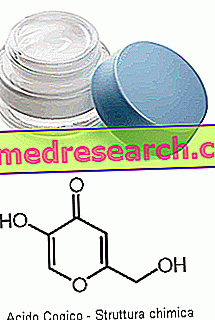Generality
Kojic acid (or kojic acid, if you prefer) is a substance known for its extraordinary lightening virtues: not surprisingly, it is widely used in cosmetics to prepare creams or gels with depigmenting action.

If, until a few years ago, kojic acid was extracted from rice bran, today, the lightening molecule par excellence is produced biotechnologically from numerous species belonging to the genus Aspergillus and Penicillium .
Curiosity
Kojic acid (also known as Kojico acid) owes its name to the main fungus that produces it: Aspergillus oryzae, a fungus that - in the Japanese language - is renamed "Koji".
Features and Properties
Kojic acid is well known for its lightening properties when applied to the skin.
At the same time, kogic acid is able to inhibit the formation of pigments also in plant tissues and not only in animal ones.
In addition to the known depigmenting properties, kogic acid also boasts antioxidant, antibacterial and antifungal properties.
Furthermore, some animal studies have shown that kogic acid could be a potential ally in protecting the body from damage caused by ionizing radiation (such as, for example, gamma rays).
Finally, other in vitro studies have shown that co-crystals of kojic acid and quercetin (a flavonoid present in many types of fruit and vegetables) exert a better cytostatic action than that of the single quercetin against malignant human tumor cells such as ovarian cancer and colon cancer. Kojic acid - in association with quercetin - could be a future and potential adjuvant therapeutic agent in the treatment of these cancers.
uses
Despite the different and potential properties of kojic acid, its use is mostly limited to the food and cosmetic fields.
In the food sector, kogic acid can be used on fruit that has already been peeled and cut in order to prevent the onset of brownish coloring, which indicates oxidation. In addition, kojic acid is used to preserve the pink or red coloration typical of seafood.
In the cosmetic field, on the other hand, this molecule is used as a depigmentant in lightening masks and creams.
Action mechanism
As mentioned, kogic acid is used in cosmetics in the treatment of skin spots of various origins (solar and senile lentigo), melasma, chloasma and other disorders characterized by cutaneous hyperpigmentation, thanks to its depigmenting action.
The mechanism of action with which kogic acid exerts this action is rather complex: the substance acts by inhibiting the biosynthesis of melanin, the main pigment that defines the color of the skin. More precisely, the cogic acid performs its function by deactivating the enzyme tyrosinase, responsible for the transformation of tyrosine in the intermediate useful for synthesizing melanin.
Kojic Acid Cosmetics
The skin has an iron memory about the solar or artificial radiations undergone: UV radiation can create devastating effects on the skin in the long term, causing evident, pronounced and premature skin aging. The most immediate side effects of solar radiation are skin hypercromia, or dark spots, if you prefer.
This is why lightening creams with cogic acid can attenuate - if not completely remove - the chromatic alterations suffered.
But the uses of kojic acid do not stop at the spots caused by the sun. The kogic acid products, in fact, are also effective in reducing other types of skin discoloration, in particular:
- Freckles;
- Melasma, chloasma or other pregnancy spots;
- Lentigo senili;
- Eye bags;
- Other acquired hyperpigmentation disorders.
The kojic acid cosmetics, of course, must be applied topically, then spread directly on the skin with altered colors.
Most of the time, this lightening substance is formulated in creams, but it can also be found in the form of lotions, gels or serums at rather low concentrations (less than or equal to 1%). To minimize the risk of cutaneous side effects, kogic acid is often used at an even lower concentration, equal to 0.2%.
The frequency of application of cosmetics based on cogic acid depends on the problem to be treated and the type of skin: for example, a hypersensitive skin does not like frequent use of the product. In such circumstances, the product must be re-evaluated.
Recommendations
After applying a cream to the kojic acid on the skin, it is recommended to spread a generous layer of sun protection (especially in summer), to preserve as much as possible the skin from the production of new melanin induced by the stimulation of ultraviolet rays.
Other brightening agents
To make a cosmetic more natural lightening and to minimize the risk of adverse reactions to the product, kogic acid can be replaced with natural molecules with a similar action. Among these substances, a major role is played by polyphenols, in particular flavonols, isoflavonoids, stilbenes and coumarins. To report a few examples, pomegranate juice is a source of ellagic acid, a compound of significant inhibitory activity on tyrosinase.
Mulberroside F, a flavonol extracted from the leaves of Morus alba, a plant used in phytotherapy due to its hypoglycemic properties, is another "bleaching" substance with a similar activity to that of cogic acid.
Similarly, even licorice extracts, thanks to the presence of isoflavonoids, exert an excellent lightening action comparable to that of kojic acid.
In a "non-natural" lightening product, kogic acid can be replaced by hydroquinone, a powerful whitening agent capable of degrading and destroying melanosomes and melanocytes. However, given its obvious side effects (erythema, desquamation, irritation, contact dermatitis etc.), the use of hydroquinone in cosmetics is prohibited: the use of this molecule requires a medical prescription.
Kojic acid and exfoliants
Kojic acid is often formulated in association with exfoliating substances. Indeed, an excellent positive effect was observed from the association of lightening substances with chemical exfoliants such as mandelic acid, salicylic acid and tartaric acid. Glycolic acid creams (with known exfoliating properties) are also often prepared in association with kojic acid or other depigmenting substances.
The embrace of lightening molecules with exfoliating substances, acting in synergy, effectively promotes the elimination of surface corneal cells - richer in melanin and responsible for dark spots on the skin - while encouraging cellular turnover.
Side effects
It is not uncommon that after one or more cosmetic treatments with cogic acid, the skin reacts negatively. Among the most common side effects related to the application of cogic acid, we recall:
- Contact allergies;
- Skin sensitization;
- Dermatitis;
- Itch.



